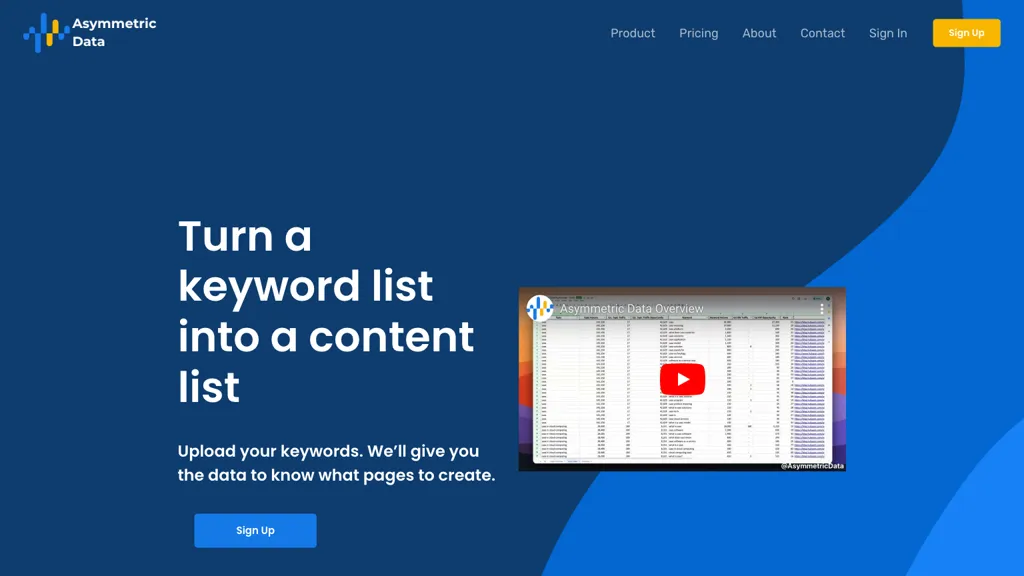What is asymmetric data?
Asymmetric Data is an innovative keyword clustering tool designed to make the process of grouping keywords according to their semantic meanings easier. It does this through painstaking analysis of search results and finding commonly appearing keywords across URLs, helping to investigate the intent of the search in question. Therefore, the result of this will be a much more optimized content strategy. This will be easier in doing keyword research, since the asymmetric data automatically groups keywords and hence improves content targeting. Its intuitive interface allows the user to group and prioritize keyword groups, which can be done in an effective manner, saving plenty of time and energy.
Key Features & Benefits of Asymmetric Data
-
Keyword Clustering:
The tool will automatically group the keywords based on semantic relationship analysis. -
Semantic Analysis:
Semantic meaning unravels the keywords deeper into your understanding of search intent. -
Automated Keyword Grouping:
Saves time with the clustering of keywords instead of having to manually intervene. -
Intuitive Interface:
Easy design and navigation around the tool for any user. -
Value-for-Money Pricing:
It offers transparent, pay-as-you-go pricing to fit into various levels of budgets.
Asymmetric Data is a one-stop solution for keyword research and optimization of content strategy. One can now reap superior search engine rankings, highly relevant content, and even targeted advertising campaigns.
Use Cases and Applications of Asymmetric Data
Asymmetric Data has numerous applications to further enhance one’s digital marketing effort:
-
Web Content Optimization:
Group keywords based on user search intent for the best SEO performance and relevance of content. -
Pay-Per-Click Campaigns:
Group keyword groups in order of ranking to make sure appropriate ad placements are given, increasing the return on investment with semantic keyword clustering. -
Content Strategy Planning:
Quickly highlight recurring themes and keywords on competitors’ websites to bring valuable insights for competitive intelligence and strategy enhancement.
This will, in turn, prove extremely helpful for marketing specialists, content creators, SEO professionals, and digital marketing agencies striving to improve their strategies.
How to Work with Asymmetric Data
Working with Asymmetric Data is quite easy, and the following are general steps involved:
-
Input Keywords:
Give a set of keywords that you want to analyze. -
Run Analysis:
Let the tool analyze these keywords and group them based on semantic relationships. -
Review Results:
Have a close look at the keywords now clustered and at the insights provided. -
Apply Insights:
Utilize the clustered keywords for content strategy, paid marketing campaigns, or SEO performance.
To make the most of this, refresh your keyword lists regularly and review clustering outputs so that your content strategies keep pace with evolving search trends.
Asymmetric Data Technology: How it Works
Asymmetric Data’s analysis uses advanced algorithms and models in performing its function:
-
Semantic Analysis:
This examines the context and meaning of the keywords underlying any given query to group them correctly. -
URL Analysis:
Analyzes results for common keywords across different URLs. -
Automated Clustering:
Once done, keywords are automatically grouped without needing further manual intervention.
Here, the workflow is such that one inputs the keyword, runs an analysis, and gets the clustered keyword groups, which one can then apply to fine-tune their content strategy, PPC campaign, or SEO efforts.
Asymmetric Data Pros and Cons
Like any other tool, Asymmetric Data does have its share of advantages and disadvantages:
Pros
-
Efficiency:
Saves one a lot of time in clustering keywords. -
Accuracy:
Provides accurate keywords groups through semantic analysis. -
Cost-effective:
The platform provides reasonably priced plans to fit different types of users.
Possible Lacks
-
Learning Curve:
A learning curve for new users to understand and operate this tool. -
Dependence on Data Quality:
Results are based on the quality of input data keywords.
Generally, user feedback speaks to a tool that makes keyword research and content optimization efforts significantly better.
Conclusion about Asymmetric Data
Asymmetric Data happens to be one of the most influential keyword clustering and content strategy optimization tools. By focusing on semantic analysis and automated keyword grouping, it saves time and effort. It is a system with its own learning curve, but well worth the digital marketers’, SEO specialists’, and content creators’ investment, since it is of great value and cost-effective. Updates are expected in the future, so this software stays competitive and entrenched in the core toolkit of every serious digital marketer.
Asymmetric Data FAQs
-
Q: What is Asymmetric Data?
- A: Keyword clustering tool that groups keywords by semantic meanings with the aim of increasing the performance of content strategy and SEO.
-
Q: For Whom Is Asymmetric Data?
- A: It would be helpful for marketing specialists, content creators, SEO experts, and digital marketing agencies.
-
Q: How does Asymmetric Data improve PPC Campaigns?
- A: Since it organizes the keyword groups in order of priority, it gives a focus to the ad placements so that the ROI could be maximum.
-
Q: What are the pricing plans available in Asymmetric Data?
- A: It provides pay-as-you-go plans, hence making it fairly economical for users coming from all walks of life.
-
Q: Are there disadvantages to using Asymmetric Data?
- A: Well, for users, it may involve a learning curve. It also depends on the accuracy of results where the onus of the same would depend upon the input keywords.










